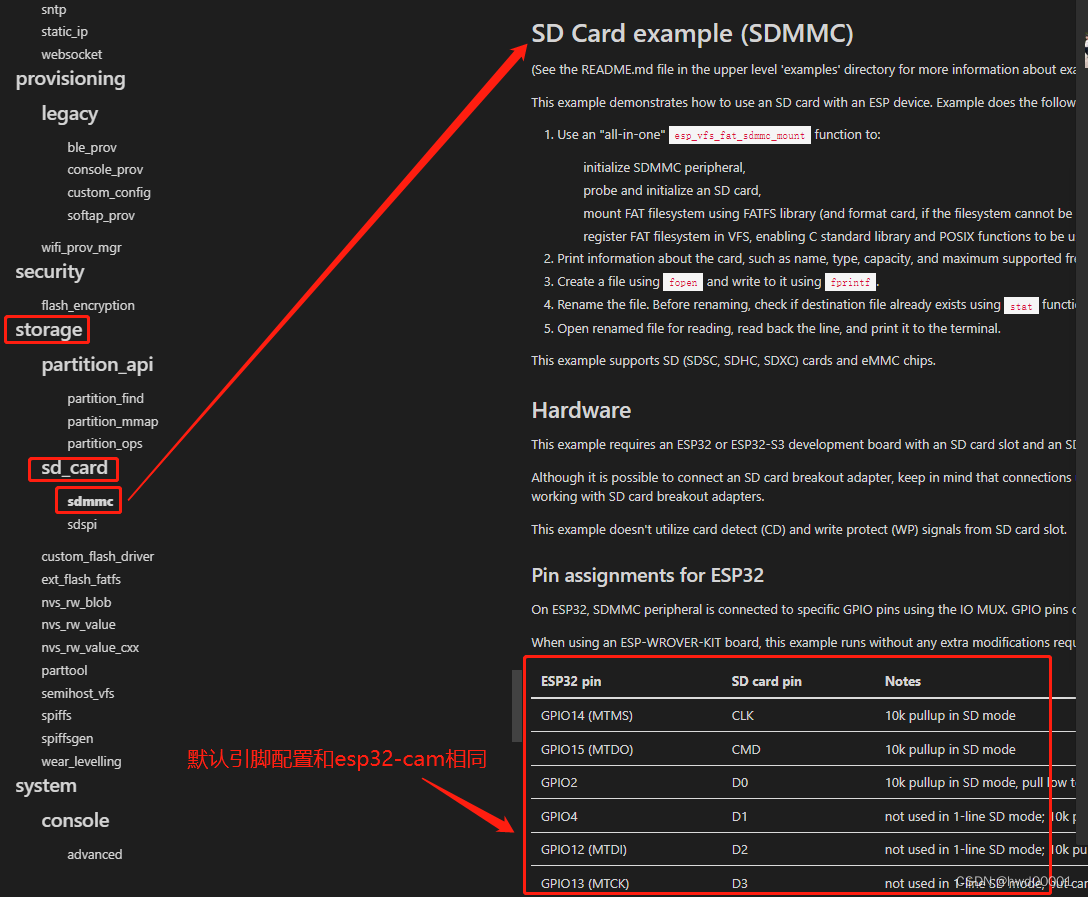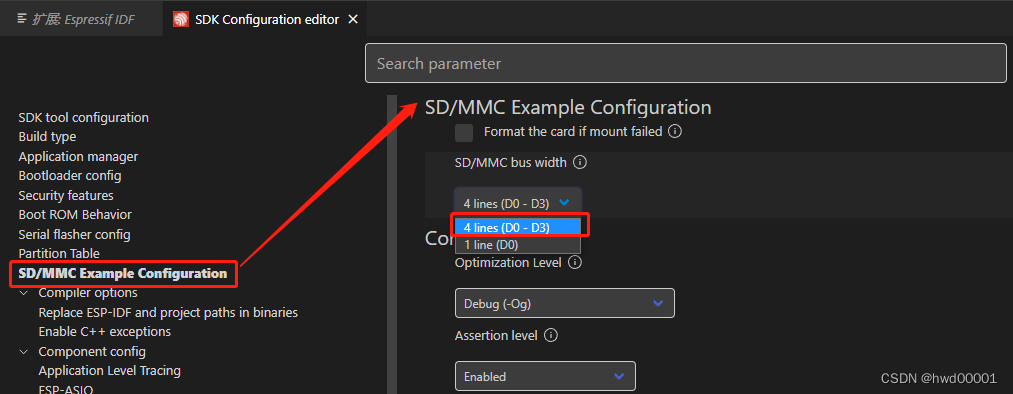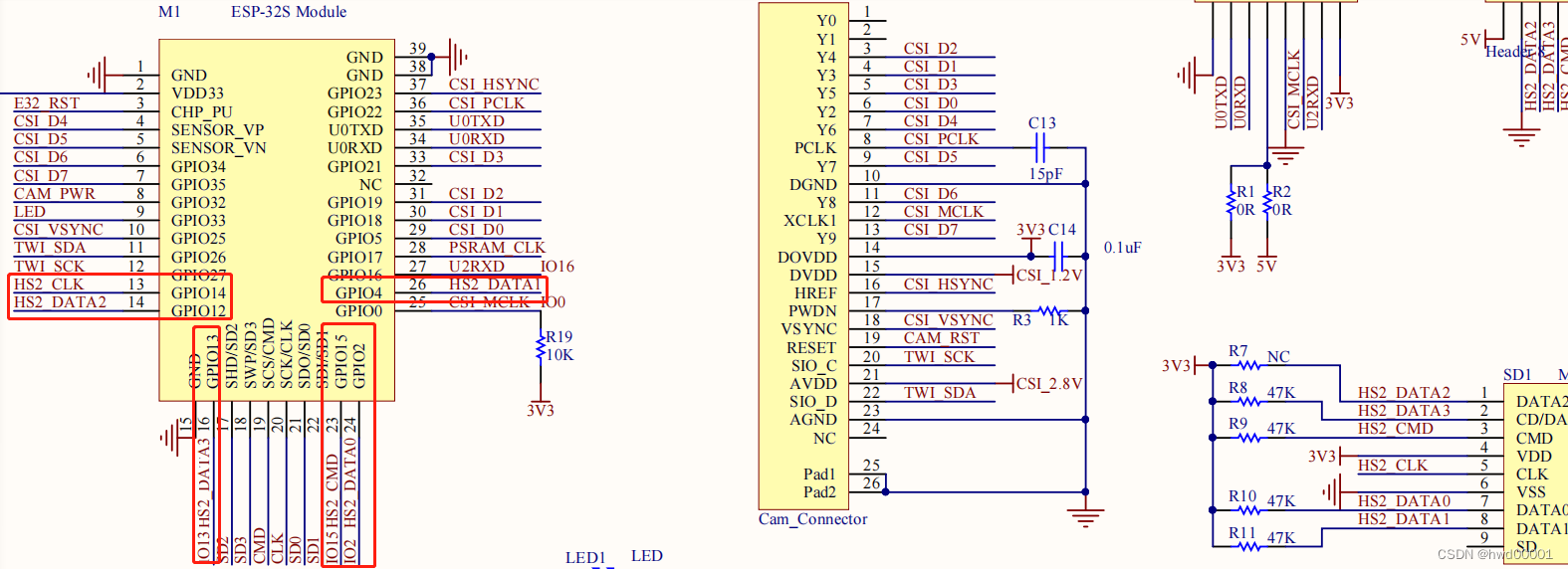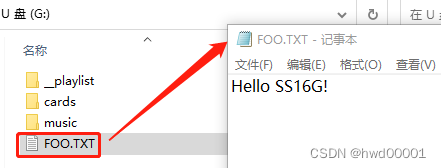VScode+esp-idf:安信可esp32-cam开发板测试sd卡
本文介绍如何使用esp-idf例程测试sd卡。
参考文章:
1.作者:Leung_ManWah,《 ESP32学习笔记(43)-- SD卡使用(SDMMC方式)》。
1.拷贝例程到目标工作区
源文件的位置在安装目录 esp-idf 下面的 example:

用vscode打开 example,打开方法参考《VScode+ESP32快速安装ESP-IDF插件》的“4.测试编译例程”。

创建好新工程后,原文件会拷贝一份到工作区。
进入下一步。
2.配置并编译工程
进入配置工程:

主要是确认一下4线接法:

esp32-cam的sd卡引脚使用图:

保存配置,编译工程。

编译完成。

3.代码逻辑流程
这里抄录参考文章的代码流程:
- 使用“一体式” esp_vfs_fat_sdmmc_mount()函数进行初始化:
- 初始化SDMMC外设;
- 检测并初始化连接到SD/MMC插槽1的卡(HS2_CMD、HS2_CLK、HS2_D0、HS2_D1、HS2_D2、HS2_D3线);
- 使用FATFS库安装FAT文件系统(如果无法安装文件系统,则使用格式化卡);
- 在VFS中注册FAT文件系统,以使用C标准库和POSIX函数。
- 打印有关SD卡的信息,例如名称、类型、容量和支持的最大频率。
- 使用fopen()创建一个文件,并使用fprintf()写入该文件。
- 重命名该文件。重命名之前,请使用stat()函数检查目标文件是否已存在,并使用unlink()函数将其删除。
- 打开重命名的文件进行读取,读回该行,并将其打印到终端。
4.烧录并运行程序
选择串口,烧录方式,是开发板处于烧录状态,点击烧录按键:

烧录完成后,运行程序,打印以下信息:
I (330) example: Initializing SD card
I (330) example: Using SDMMC peripheral
I (340) example: Mounting filesystem
I (340) gpio: GPIO[13]| InputEn: 0| OutputEn: 1| OpenDrain: 0| Pullup: 0| Pulldown: 0| Intr:0
I (540) example: Filesystem mounted
Name: SS16G
Type: SDHC/SDXC
Speed: 20 MHz
Size: 15193MB
I (540) example: Opening file /sdcard/hello.txt
I (620) example: File written
I (620) example: Renaming file /sdcard/hello.txt to /sdcard/foo.txt
I (630) example: Reading file /sdcard/foo.txt
I (630) example: Read from file: 'Hello SS16G!'
I (630) example: Card unmounted
给开发板断电,取下sd卡,用读卡器在电脑上查看:

5.源代码main()
static const char *TAG = "example";
#define MOUNT_POINT "/sdcard"
void app_main(void)
{
esp_err_t ret;
// Options for mounting the filesystem.
// If format_if_mount_failed is set to true, SD card will be partitioned and
// formatted in case when mounting fails.
esp_vfs_fat_sdmmc_mount_config_t mount_config = {
#ifdef CONFIG_EXAMPLE_FORMAT_IF_MOUNT_FAILED
.format_if_mount_failed = true,
#else
.format_if_mount_failed = false,
#endif // EXAMPLE_FORMAT_IF_MOUNT_FAILED
.max_files = 5,
.allocation_unit_size = 16 * 1024
};
sdmmc_card_t *card;
const char mount_point[] = MOUNT_POINT;
ESP_LOGI(TAG, "Initializing SD card");
// Use settings defined above to initialize SD card and mount FAT filesystem.
// Note: esp_vfs_fat_sdmmc/sdspi_mount is all-in-one convenience functions.
// Please check its source code and implement error recovery when developing
// production applications.
ESP_LOGI(TAG, "Using SDMMC peripheral");
sdmmc_host_t host = SDMMC_HOST_DEFAULT();
// This initializes the slot without card detect (CD) and write protect (WP) signals.
// Modify slot_config.gpio_cd and slot_config.gpio_wp if your board has these signals.
sdmmc_slot_config_t slot_config = SDMMC_SLOT_CONFIG_DEFAULT();
// Set bus width to use:
#ifdef CONFIG_EXAMPLE_SDMMC_BUS_WIDTH_4
slot_config.width = 4;
#else
slot_config.width = 1;
#endif
// On chips where the GPIOs used for SD card can be configured, set them in
// the slot_config structure:
#ifdef CONFIG_SOC_SDMMC_USE_GPIO_MATRIX
slot_config.clk = CONFIG_EXAMPLE_PIN_CLK;
slot_config.cmd = CONFIG_EXAMPLE_PIN_CMD;
slot_config.d0 = CONFIG_EXAMPLE_PIN_D0;
#ifdef CONFIG_EXAMPLE_SDMMC_BUS_WIDTH_4
slot_config.d1 = CONFIG_EXAMPLE_PIN_D1;
slot_config.d2 = CONFIG_EXAMPLE_PIN_D2;
slot_config.d3 = CONFIG_EXAMPLE_PIN_D3;
#endif // CONFIG_EXAMPLE_SDMMC_BUS_WIDTH_4
#endif // CONFIG_SOC_SDMMC_USE_GPIO_MATRIX
// Enable internal pullups on enabled pins. The internal pullups
// are insufficient however, please make sure 10k external pullups are
// connected on the bus. This is for debug / example purpose only.
slot_config.flags |= SDMMC_SLOT_FLAG_INTERNAL_PULLUP;
ESP_LOGI(TAG, "Mounting filesystem");
ret = esp_vfs_fat_sdmmc_mount(mount_point, &host, &slot_config, &mount_config, &card);
if (ret != ESP_OK) {
if (ret == ESP_FAIL) {
ESP_LOGE(TAG, "Failed to mount filesystem. "
"If you want the card to be formatted, set the EXAMPLE_FORMAT_IF_MOUNT_FAILED menuconfig option.");
} else {
ESP_LOGE(TAG, "Failed to initialize the card (%s). "
"Make sure SD card lines have pull-up resistors in place.", esp_err_to_name(ret));
}
return;
}
ESP_LOGI(TAG, "Filesystem mounted");
// Card has been initialized, print its properties
sdmmc_card_print_info(stdout, card);
// Use POSIX and C standard library functions to work with files:
// First create a file.
const char *file_hello = MOUNT_POINT"/hello.txt";
ESP_LOGI(TAG, "Opening file %s", file_hello);
FILE *f = fopen(file_hello, "w");
if (f == NULL) {
ESP_LOGE(TAG, "Failed to open file for writing");
return;
}
fprintf(f, "Hello %s!\n", card->cid.name);
fclose(f);
ESP_LOGI(TAG, "File written");
const char *file_foo = MOUNT_POINT"/foo.txt";
// Check if destination file exists before renaming
struct stat st;
if (stat(file_foo, &st) == 0) {
// Delete it if it exists
unlink(file_foo);
}
// Rename original file
ESP_LOGI(TAG, "Renaming file %s to %s", file_hello, file_foo);
if (rename(file_hello, file_foo) != 0) {
ESP_LOGE(TAG, "Rename failed");
return;
}
// Open renamed file for reading
ESP_LOGI(TAG, "Reading file %s", file_foo);
f = fopen(file_foo, "r");
if (f == NULL) {
ESP_LOGE(TAG, "Failed to open file for reading");
return;
}
// Read a line from file
char line[64];
fgets(line, sizeof(line), f);
fclose(f);
// Strip newline
char *pos = strchr(line, '\n');
if (pos) {
*pos = '\0';
}
ESP_LOGI(TAG, "Read from file: '%s'", line);
// All done, unmount partition and disable SDMMC peripheral
esp_vfs_fat_sdcard_unmount(mount_point, card);
ESP_LOGI(TAG, "Card unmounted");
}



